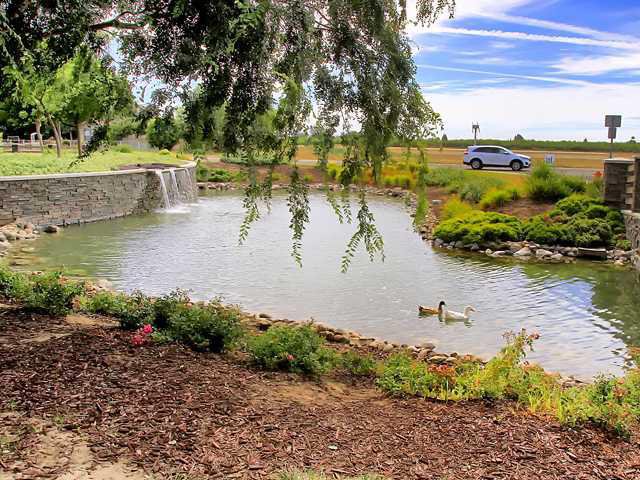Manteca is practicing what it preaches in how it manages landscape maintenance districts.
The LMDs — that typically encompass sound walls and adjoining landscaping around neighborhoods as well as other common landscaped areas within a subdivision — have not only cutback water use to help the city meet its state mandated goal of 27 percent less water consumption than in 2013 but also are employing best practices that result in grass being able to weather heat with less water.
The key was raising the standard mowing height that reduces root exposure to sun and heat. That added protection requires less water to keep grass in a presentable state.
Up until 2009 the city contracted out maintenance for the LMDs. That is when city crews were assigned to do the work as a way to reduce job losses as the Great Recession triggered significant cuts in property and sales taxes that power general fund spending.
Initially there was skepticism from the development community and homeowners within LMDs whether the city could do as good as a job and keep costs down. Within a year the detractors were in agreeance that Manteca was delivering on its promise to contain costs, keep up the quality of work and — in some cases — make significant improvements in maintenance without increasing expenditures.
“Things continue to go well with city forces doing the work in (LMDs and community facilities districts),” City Manager Karen McLaughlin said. “”They take pride in providing a quality end product at a reasonable price.”
The drought has prompted city staff to limit tree and plant replacements to specific needs.
The LMD staff evaluates each area that needs replanting to determine if they should replant as it was designed, less than before, or nothing at all.
“Of an area does no need full replanting, we may only add bark or only a tree,” McLaughlin noted. “It depends on the visual/functional need and each individual LMD’s budget.”
The city is also limiting replanting when possible to the fall or winter to conserve water.
The City Council in 2014 directed staff to start employing more drought resistant plants in the design of new LMDs. The practice is known as xeriscape. . Such landscaping can thrive in dry conditions with minimal water. Xeriscape first took off in the Denver area due to growth taxing their available water resources.
The city has more than 60 acres of landscape maintenance districts that are irrigated using treated municipal water. That’s unlike a growing number of city parks that have relatively shallow wells that tap into the upper part of the aquifer where water is not considered safe for drinking.
And because xeriscape uses less water, it also will cost homeowners that foot the bill in such districts less money. Water is the second biggest expense in such districts behind labor.
Two years after the city took over LMD upkeep that had been contracted to private firms; it was reported by municipal staff in 2011 that water savings per district ranged from 5 to 15 percent. That’s because the city imposed water conservation measures to keep costs down ahead of the drought hitting.
Budget crisis triggered
events that eventually
led to formation of LMDs
The decision that ultimately set in motion LMDs was the 1980s municipal budget crisis that gave birth to Manteca canyons.
The city teetered on the brink of bankruptcy caused by the failure to impose fees on growth to pay for its share of municipal services. The city had a new fire station on Louise Avenue that remained shuttered because they couldn’t afford to staff it. Police were issued used CJHP cars that had 90,000 miles on them when they were first put into service in Manteca. The city had just $1,800 in reserves.
The edict went out. Avoid creating expenses.
So when projects started moving forward designs were basic when it came to main corridors – five lanes of uninterrupted asphalt running into swaths of concrete abutting six-foot high masonry walls. The only relief was occasional trees planted in wells created in the sidewalk.
The cost to maintain the sound walls was minimal.
Eighteen years later, Manteca residents began to balk at attempts to continue the design. They managed to stop a “Super Manteca Canyon” from going down Fishback Road to the west of Sierra High. The initial – and final – segment that raised their ire can be seen immediately south of Wawona Street.
There were several attempts to upgrade landscaping but sterile sound walls won out on new projects as no council member wanted city taxpayers to pick up the cost of maintenance. The dismal failure of the Magna Terra Home Owners Association in the neighborhood immediately north of Doctors Hospital had soured elected leaders on allowing HOAs as a way to pay for the upkeep of upgraded landscaping along corridors.
The birth of landscape maintenance districts (LMD) as a way of paying for upkeep of sound walls and upgraded landscaping came in 1999 after Curran Grove, the 177-home neighborhood on the southeast corner of Powers and Yosemite avenues that replaced the old Spreckels Sugar almond orchard was built.
A split council had debated putting in place an LMD to allow more intense landscaping for Curran Grove. In the end, the argument that it was in effect creating taxes on future residents who would buy the homes won out until the council saw what that directive provided – a small corner of shrubs and tulips – along with the traditional Manteca tree in a concrete well approach to streetscape.
Shortly thereafter a split council directed staff to start deploying LMDs. The initial results were the landscaping areas along Chadwick Square in northwest Manteca that ultimately led to other new developments in Manteca receiving similar treatment.
USING LESS WATER
City sets example with LMDs



